Parsimonious Scenario for the Emergence of Viroid-Like Replicons De Novo
Abstract
1. Introduction
2. Materials and Methods
2.1. Structural Properties of Extant Viroids
2.2. Computational Model
3. Results
3.1. Quantitative Properties of Viroid-Like RNA Sequences and Folds
3.1.1. Structural Properties of Circular RNAs
3.1.2. Phenotype Sizes
3.1.3. Probability of Specific Sequence Motifs in Random Sequences
3.2. Evolutionary Dynamics of Circular RNAs of Fixed Length
3.3. Evolutionary Dynamics of Circular RNAs of Increasing Length
3.3.1. Growth through Insertion of Single Nucleotides
3.3.2. Growth through Modular Recombination
4. Discussion
Author Contributions
Funding
Acknowledgments
Conflicts of Interest
Abbreviations
| ADFVd | Apple dimple fruit viroid | X99487.1 | |
| AFCVd | Apple fruit crinkle viroid | AB429213.1 | |
| AGVd | Australian grapevine viroid | X17101.1 | |
| ASBVd | Avocado sunblotch viroid | X13000.1 | |
| ASSVd | Apple scar skin viroid | X17696.1 | |
| CBVd | Coleus blumei viroid | X97202.1 | |
| X52960.1 | (CBVd-1) | ||
| X95365.1 | (CBVd-2) | ||
| X95364.1 | (CBVd-3) | ||
| CBCVd | Citrus bark cracking viroid | MG457794.1 | |
| CBLVd | Citrus bent leaf viroid | M74065.1 | |
| CVd | Citrus viroid | EF617306.1 | (CVd-V) |
| AB019508.1 | (CVd-VI) | ||
| KX013553.1 | (CVd-VII) | ||
| CCCVd | Coconut cadang-cadang viroid | J02049.1 | |
| CChMVd | Chrysanthemum chlorotic mottle viroid | Y14700.1 | |
| CDVd | Citrus dwarfing viroid | AF184147.1 | |
| CEVd | Citrus exocortis viroid | M34917.1 | |
| CLVd | Columnea latent viroid | X15663.1 | |
| CSVd | Chrysanthemum stunt viroid | AJ001849.1 | |
| CTiVd | Coconut trinangaja viroid | M20731.1 | |
| DLVd | Dahlia latent viroid | MG214159.1 | |
| ELVd | Eggplant latent viroid | AJ536612.1 | |
| GLVd | Grapevine latent viroid | KR605505.1 | |
| GYSVd | Grapevine yellow speckle viroid | X06904.1 | |
| J04348.1 | (GYSVd-1) | ||
| KF916050.1 | (GYSVd-2) | ||
| HLVd | Hop latent viroid | X07397.1 | |
| HSVd | Hop stunt viroid | X00009.1 | |
| IrVd | Iresine viroid | X95734.1 | |
| MPVd | Mexican papita viroid | L78454.1 | |
| PVd | Persimmon viroid | AB366022.1 | |
| AB817729.1 | (PVd2) | ||
| PBCVd | Pear blister canker viroid | D12823.1 | |
| PCFVd | Pepper chat fruit viroid | FJ409044.1 | |
| PLMVd | Peach latent mosaic viroid | M83545.1 | |
| PSTVd | Potato spindle tuber viroid | V01465.1 | |
| RVd | Rubber viroid | HM107844.1 | (RVd-I) |
| TASVd | Tomato apical stunt viroid | K00818.1 | |
| TCDVd | Tomato chlorotic dwarf viroid | AF162131.1 | |
| TPMVd | Tomato planta macho viroid | K00817.1 |
References
- Diener, T.O. Potato spindle tuber “virus”: IV. A replicating, low molecular weight RNA. Virology 1971, 45, 411–428. [Google Scholar] [CrossRef]
- Diener, T.O. Are viroids escaped introns? Proc. Natl. Acad. Sci. USA 1981, 78, 5014–5015. [Google Scholar] [CrossRef] [PubMed]
- Kiefer, M.C.; Owens, R.A.; Diener, T.O. Structural similarities between viroids and transposable genetic elements. Proc. Natl. Acad. Sci. USA 1983, 80, 6234–6238. [Google Scholar] [CrossRef]
- Diener, T.O. Viroids as prototypes or degeneration products of viruses. In Viruses, Evolution and Cancer; Kurstak, E., Maramorosch, K., Eds.; Academic Press: New York, NY, USA, 1974; pp. 757–783. [Google Scholar]
- Flores, R.; Gago-Zachert, S.; Serra, P.; Sanjuán, R.; Elena, S.F. Viroids: Survivors from the RNA world? Annu. Rev. Microbiol. 2014, 68, 395–414. [Google Scholar] [CrossRef]
- Diener, T.O. Origin and evolution of viroids and viroid-like satellite RNAs. Virus Genes 1996, 11, 119–131. [Google Scholar] [CrossRef]
- Di Serio, F.; Navarro, B.; Flores, R. Origin and evolution of viroids. In Viroids and Satellites; Hadidi, A., Flores, R., Randles, J., Palukaitis, P., Eds.; Academic Press: New York, NY, USA, 2017; pp. 125–134. [Google Scholar]
- Jenkins, G.M.; Woelk, C.H.; Rambaut, A.; Holmes, E.C. Testing the extent of sequence similarity among viroids, satellite RNAs, and hepatitis delta virus. J. Mol. Evol. 1983, 50, 98–102. [Google Scholar] [CrossRef]
- Diener, T.O. Viroids: “living fossils” or primordial RNAs? Biol. Direct 2016, 11, 15. [Google Scholar] [CrossRef]
- Flores, R.; Serra, P.; Minoia, S.; di Serio, F.; Navarro, B. Viroids: From genotype to phenotype just relying on RNA sequence and structural motifs. Front. Microbiol. 2012, 3, 217. [Google Scholar] [CrossRef]
- Palukaitis, P. What has been happening with viroids? Virus Genes 2014, 49, 175–184. [Google Scholar] [CrossRef]
- Steger, G.; Perreault, J.P. Structure and associated biological functions of viroids. Adv. Virus Res. 2016, 94, 141–172. [Google Scholar]
- Elena, S.F.; Gómez, G.; Daròs, J.A. Evolutionary constraints to viroid evolution. Viruses 2009, 1, 241–254. [Google Scholar] [CrossRef]
- Sanjuán, R.; Forment, J.; Elena, S.F. In silico predicted robustness of viroids RNA secondary structures. I. The effect of single mutations. Mol. Biol. Evol. 2006, 23, 1427–1436. [Google Scholar] [CrossRef]
- Sanjuán, R.; Forment, J.; Elena, S.F. In silico predicted robustness of viroids RNA secondary structures. II. Interactions between mutation pairs. Mol. Biol. Evol. 2006, 23, 2123–2130. [Google Scholar] [CrossRef]
- Codoñer, F.M.; Darós, J.A.; Solé, R.V.; Elena, S.F. The fittest versus the flattest: Experimental confirmation of the quasispecies effect with subviral pathogens. PLoS Pathog. 2006, 2, e136. [Google Scholar] [CrossRef]
- Domingo, E. (Ed.) Quasispecies: Concept and Implications for Virology; Springer: Berlin, Germany, 2006. [Google Scholar]
- Gago, S.; Elena, S.F.; Flores, R.; Sanjuán, R. Extremely high mutation tate of a hammerhead viroid. Science 2009, 323, 1308. [Google Scholar] [CrossRef]
- López-Carrasco, A.; Ballesteros, C.; Sentandreu, V.; Delgado, S.; Gago-Zachert, S.; Flores, R.; Sanjuán, R. Different rates of spontaneous mutation of chloroplastic and nuclear viroids as determined by high-fidelity ultra-deep sequencing. PLoS Pathog. 2017, 13, e1006547. [Google Scholar] [CrossRef]
- Glouzon, J.P.S.; Bolduc, F.; Wang, S.; Najmanovich, R.J.; Perreault, J.P. Deep-sequencing of the Peach latent mosaic viroid reveals new aspects of population heterogeneity. PLoS ONE 2014, 9, e87297. [Google Scholar] [CrossRef]
- Jianga, D.; Sano, T.; Tsuji, M.; Araki, H.; Sagawa, K.; Purushothama, C.R.A.; Zhang, Z.; Guo, R.; Xie, L.; Wu, Z.; et al. Comprehensive diversity analysis of viroids infecting grapevine in China and Japan. Virus Res. 2012, 169, 237–245. [Google Scholar] [CrossRef]
- Matoušek, J.; Patzak, J.; Orctová, L.; Schubert, J.; Vrba, L.; Steger, G.; Riesner, D. The variability of hop latent viroid as induced upon heat treatment. Virology 2001, 287, 349–358. [Google Scholar] [CrossRef]
- Bernad, L.; Durán-Vila, N.; Elena, S.F. Effect of citrus hosts on the generation, maintenance and evolutionary fate of genetic variability of citrus exocortis viroid. J. Gen. Virol. 2009, 90, 2040–2049. [Google Scholar] [CrossRef]
- Diener, T.O. Circular RNAs: Relics of precellular evolution? Proc. Natl. Acad. Sci. USA 1989, 86, 9370–9374. [Google Scholar] [CrossRef]
- Kacian, D.L.; Mills, D.R.; Kramer, F.R.; Spiegelman, S. A replicating RNA molecule suitable for a detailed analysis of extracellular evolution and replication. Proc. Natl. Acad. Sci. USA 1972, 69, 3038–3042. [Google Scholar] [CrossRef]
- Maurel, M.C.; Leclerc, F.; Vergne, J.; Zaccai, G. RNA back and forth: Looking through ribozyme and viroid motifs. Viruses 2019, 11, 283. [Google Scholar] [CrossRef]
- Palukaitis, P. Satellite RNAs and satellite viruses. Mol. Plant Microbe Interact. 2016, 29, 181–186. [Google Scholar] [CrossRef]
- Daròs, J.A.; Flores, R. Identification of a retroviroid-like element from plants. Proc. Natl. Acad. Sci. USA 1995, 92, 6856–6860. [Google Scholar] [CrossRef]
- Di Serio, F.; Daròs, J.A.; Ragozzino, A.; Flores, R. A 451-nucleotide circular RNA from cherry with hammerhead ribozymes in its strands of both polarities. J. Virol. 1997, 71, 6603–6610. [Google Scholar]
- Chen, P.J.; Kalpana, G.; Goldberg, J.; Mason, W.; Werner, B.; Gerin, J.; Taylor, J. Structure and replication of the genome of the hepatitis δ virus. Proc. Natl. Acad. Sci. USA 1986, 83, 8774–8778. [Google Scholar] [CrossRef]
- Flores, R.; Owens, R.A.; Taylor, J. Pathogenesis by subviral agents: Viroids and hepatitis delta virus. Curr. Opin. Virol. 2016, 17, 87–94. [Google Scholar] [CrossRef]
- Elena, S.F.; Dopazo, J.; Flores, R.; Diener, T.O.; Moya, A. Phylogeny of viroids, viroidlike satellite RNAs, and the viroidlike domain of hepatitis δ virus. Proc. Natl. Acad. Sci. USA 1991, 88, 5631–5634. [Google Scholar] [CrossRef]
- Lorenz, R.; Bernhart, S.H.; Höner zu Siederdissen, C.; Tafer, H.; Flamm, C.; Stadler, P.F.; Hofacker, I.L. ViennaRNA Package 2.0. Algorithms Mol. Biol. 2011, 6, 26. [Google Scholar] [CrossRef]
- Juhász, A.; Hegyi, H.; Solymosy, F. A novel aspect of the information content of viroids. Biochim. Biophys. Acta 1988, 950, 455–458. [Google Scholar] [CrossRef]
- Stich, M.; Lázaro, E.; Manrubia, S.C. Phenotypic effect of mutations in evolving populations of RNA molecules. BMC Evol. Biol. 2010, 10, 46. [Google Scholar] [CrossRef]
- Ryu, W.S. Molecular Virology of Human Pathogenic Viruses; Academic Press: New York, NY, USA, 2017; pp. 277–288. [Google Scholar]
- Cuesta, J.A.; Manrubia, S. Enumerating secondary structures and structural moieties for circular RNAs. J. Theor. Biol. 2017, 419, 375–382. [Google Scholar] [CrossRef][Green Version]
- Schuster, P.; Fontana, W.; Stadler, P.F.; Hofacker, I.L. From sequences to shapes and back: A case study in RNA secondary structures. Proc. R. Soc. B 1994, 255, 279–284. [Google Scholar]
- Ahnert, S.E. Structural properties of genotype-phenotype maps. J. R. Soc. Interface 2017, 14, 20170275. [Google Scholar] [CrossRef]
- Manrubia, S.; Cuesta, J.A. Distribution of genotype network sizes in sequence-to-structure genotype-phenotype maps. J. R. Soc. Interface 2017, 14, 20160976. [Google Scholar] [CrossRef]
- Stich, M.; Briones, C.; Manrubia, S.C. On the structural repertoire of pools of short, random RNA sequences. J. Theor. Biol. 2008, 252, 750–763. [Google Scholar] [CrossRef][Green Version]
- Huynen, M.A. Exploring phenotype space through neutral evolution. J. Mol. Evol. 1996, 43, 165–169. [Google Scholar] [CrossRef]
- Reidys, C.M.; Forst, C.V.; Stadler, P.F. Replication and mutation on neutral networks. Bull. Math. Biol. 2001, 63, 57–94. [Google Scholar] [CrossRef]
- Garcia-Martin, J.A.; Catalán, P.; Cuesta, J.A.; Manrubia, S. Phenotype size distributions in exact enumerations of genotype spaces. Europhys. Lett. 2018, 123, 28001. [Google Scholar] [CrossRef]
- Dingle, K.; Schaper, S.; Louis, A.A. The structure of the genotype-phenotype map strongly constrains the evolution of non-coding RNA. J. R. Soc. Interface 2015, 5, 20150053. [Google Scholar] [CrossRef]
- Abraitienea, A.; Zhao, Y.; Hammond, R. Nuclear targeting by fragmentation of the Potato spindle tuber viroid genome. Biochem. Biophys. Res. Commun. 2008, 368, 470–475. [Google Scholar] [CrossRef]
- Serra, P.; Gago, S.; Duran-Vila, N. A single nucleotide change in Hop stunt viroid modulates citrus cachexia symptoms. Virus Res. 2008, 138, 130–134. [Google Scholar] [CrossRef]
- Zhong, X.; Leontis, N.; Qian, S.; Itaya, A.; Qi, Y.; Boris-Lawrie, K.; Ding, B. Tertiary structural and functional analyses of a viroid RNA motif by isostericity matrix and mutagenesis reveal its essential role in replication. J. Virol. 2006, 80, 8566–8581. [Google Scholar] [CrossRef]
- Dufour, D.; de la Peña, M.; Gago, S.; Flores, R.; Gallego, J. Structure-function analysis of the ribozymes of chrysanthemum chlorotic mottle viroid: A loop-loop interaction motif conserved in most natural hammerheads. Nucleic Acids Res. 2009, 37, 368–381. [Google Scholar] [CrossRef]
- Nohales, M.A.; Flores, R.; Daròs, J.A. Viroid RNA redirects host DNA ligase 1 to act as an RNA ligase. Proc. Natl. Acad. Sci. USA 2012, 109, 13805–13810. [Google Scholar] [CrossRef]
- Manrubia, S.; Sanjuán, R. Shape matters: Effect of point mutations on RNA secondary structure. Adv. Complex Syst. 2013, 16, 2050052. [Google Scholar] [CrossRef]
- Szabo, L.; Salzman, J. Detecting circular RNAs: Bioinformatic and experimental challenges. Nat. Rev. Genet. 2016, 17, 679–692. [Google Scholar] [CrossRef]
- De la Peña, M. Circular RNAs biogenesis in eukaryotes through self-cleaving hammerhead ribozymes. In Circular RNAs; Xiao, J., Ed.; Springer Nature: Singapore, 2018; pp. 53–63. [Google Scholar]
- Bartel, D.P. MicroRNAs: Genomics, biogenesis, mechanism, and function. Cell 2004, 116, 281–297. [Google Scholar] [CrossRef]
- Hill, J.M.; Zhao, Y.; Bhattacharjee, S.; Lukiw, W.J. miRNAs and viroids utilize common strategies in genetic signal transfer. Front. Mol. Neurosci. 2014, 7, 10. [Google Scholar] [CrossRef]
- Briones, C.; Stich, M.; Manrubia, S.C. The dawn of the RNA World: Toward functional complexity through ligation of random RNA oligomers. RNA 2009, 15, 743–749. [Google Scholar] [CrossRef]
- Puerta-Fernández, E.; Romero-López, C.; del Jesus, A.B.; Berzal-Herranz, A. Ribozymes: Recent advances in the development of RNA tools. FEMS Microbiol. Rev. 2003, 27, 75–97. [Google Scholar] [CrossRef]
- Petkovic, S.; Müller, S. RNA self-processing: Formation of cyclic species and concatemers from a small engineered RNA. FEBS Lett. 2013, 587, 2435–2440. [Google Scholar] [CrossRef]
- Buzayan, J.M.; Gerlach, W.L.; Bruening, G. Nonenzymatic cleavage and ligation of RNAs complementary to a plant virus satellite RNA. Nature 1986, 323, 349–353. [Google Scholar] [CrossRef]
- Fedor, M.J. Structure and function of the hairpin ribozyme. J. Mol. Biol. 2000, 24, 269–291. [Google Scholar] [CrossRef]
- Komatsu, Y.; Koizumi, M.; Sekiguichi, A.; Ohtsuka, E. Cross-ligation and exchange reactions catalyzed by hairpin ribozymes. Nucleic Acids Res. 1993, 21, 185–190. [Google Scholar] [CrossRef]
- Qin, L.; Zhang, Z.; Zhao, X.; Wu, X.; Chen, Y.; Tan, Z.; Li, S. Survey and analysis of simple sequence repeats (SSRs) present in the genomes of plant viroids. FEBS Open Biol. 2014, 4, 185–189. [Google Scholar] [CrossRef]
- Hammond, R.; Smith, D.R.; Diener, T.O. Nucleotide sequence and proposed secondary structure of Columnea latent viroid: A natural mosaic of viroid sequences. Nucleic Acids Res. 1989, 17, 10083–10094. [Google Scholar] [CrossRef]
- Rezaian, M.A. Australian grapevine viroid—Evidence for extensive recombination between viroids. Nucleic Acids Res. 1990, 18, 1813–1818. [Google Scholar] [CrossRef]
- Weiner, A.J.; Choo, Q.L.; Wang, K.S.; Govindarajan, S.; Redeker, A.G.; Gerin, J.L.; Houghton, M. A single antigenomic open reading frame of the hepatitis delta virus encodes the epitope(s) of both hepatitis delta antigen polypeptides p24 delta and p27 delta. J. Virol. 1988, 62, 594–599. [Google Scholar]
- Manrubia, S.C.; Briones, C. Modular evolution and increase of functional complexity in replicating RNA molecules. RNA 2007, 13, 97–107. [Google Scholar] [CrossRef][Green Version]
- Hammann, C.; Luptak, A.; Perreault, J.; de la Peña, M. The ubiquitous hammerhead ribozyme. RNA 2012, 18, 871–885. [Google Scholar] [CrossRef]
- Cervera, A.; Urbina, D.; de la Peña, M. Retrozymes are a unique family of non-autonomous retrotransposons with hammerhead ribozymes that propagate in plants through circular RNAs. Genome Biol. 2016, 17, 135. [Google Scholar] [CrossRef]
- De la Peña, M.; Cervera, A. Circular RNAs with hammerhead ribozymes encoded in eukaryotic genomes: The enemy at home. RNA Biol. 2017, 14, 985–991. [Google Scholar] [CrossRef]
- Lasda, E.; Parker, R. Circular RNAs: Diversity of form and function. RNA 2014, 20, 1829–1842. [Google Scholar] [CrossRef]
- Biebricher, C.K.; Eigen, M.; Luce, R. Template-free RNA synthesis by Qβ replicase. Nature 1986, 321, 89–91. [Google Scholar] [CrossRef]
- Kassen, R.; Llewellyn, M.; Rainey, P.B. Ecological constraints on diversification in a model adaptive radiation. Nature 2004, 431, 984–988. [Google Scholar] [CrossRef]
- Brockhurst, M.A.; Colegrave, N.; Hodgson, D.J.; Buckling, A. Niche Occupation Limits Adaptive Radiation in Experimental Microcosms. PLoS ONE 2007, 2, e193. [Google Scholar] [CrossRef]
- Spieker, R.L. In vitro-generated ‘inverse’ chimeric Coleus blumei viroids evolve in vivo into infectious RNA replicons. J. Gen. Virol. 1996, 77, 2839–2846. [Google Scholar] [CrossRef]
- Haseloff, J.; Mohamed, N.A.; Symons, R.H. Viroid RNAs of cadang-cadang disease of coconuts. Nature 1982, 299, 316–321. [Google Scholar] [CrossRef]
- Semancik, J.S.; Szychowski, J.A.; Rakowski, A.G.; Symons, R.H. A stable 463-nucleotide variant of citrus exocortis viroid produced by terminal repeats. J. Gen. Virol. 1994, 75, 727–732. [Google Scholar] [CrossRef]
- Iranzo, J.; Krupovic, M.; Koonin, E.V. The double-stranded DNA virosphere as a modular hierarchical network of gene sharing. mBio 2016, 7, e00978. [Google Scholar] [CrossRef]
- Lucía-Sanz, A.; Manrubia, S. Multipartite viruses: Adaptive trick or evolutionary treat? NPJ Syst. Biol. Appl. 2017, 3, 34. [Google Scholar] [CrossRef]
- Iranzo, J.; Puigbó, P.; Lobkovsky, A.E.; Wolf, Y.I.; Koonin, E.V. Inevitability of genetic parasites. Genome Biol. Evol. 2016, 8, 2856–2869. [Google Scholar] [CrossRef]
- Koonin, E.V.; Wolf, Y.I.; Katsnelson, M.I. Inevitability of the emergence and persistence of genetic parasites caused by evolutionary instability of parasite-free states. Biol. Direct 2017, 12, 31. [Google Scholar] [CrossRef] [PubMed]
- Ding, B. The biology of viroid-host interactions. Annu. Rev. Phytopathol. 2009, 47, 105–131. [Google Scholar] [CrossRef]
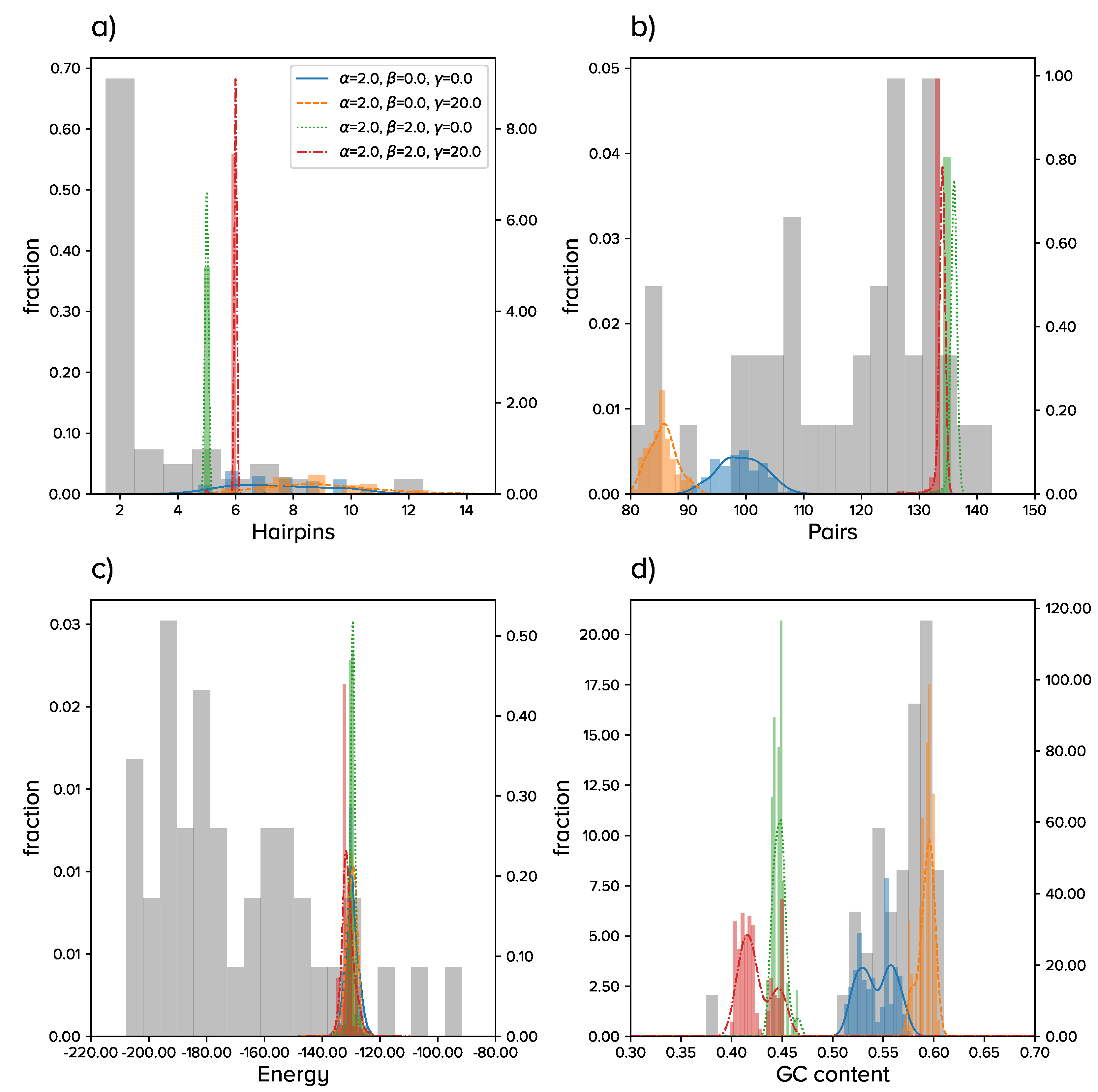
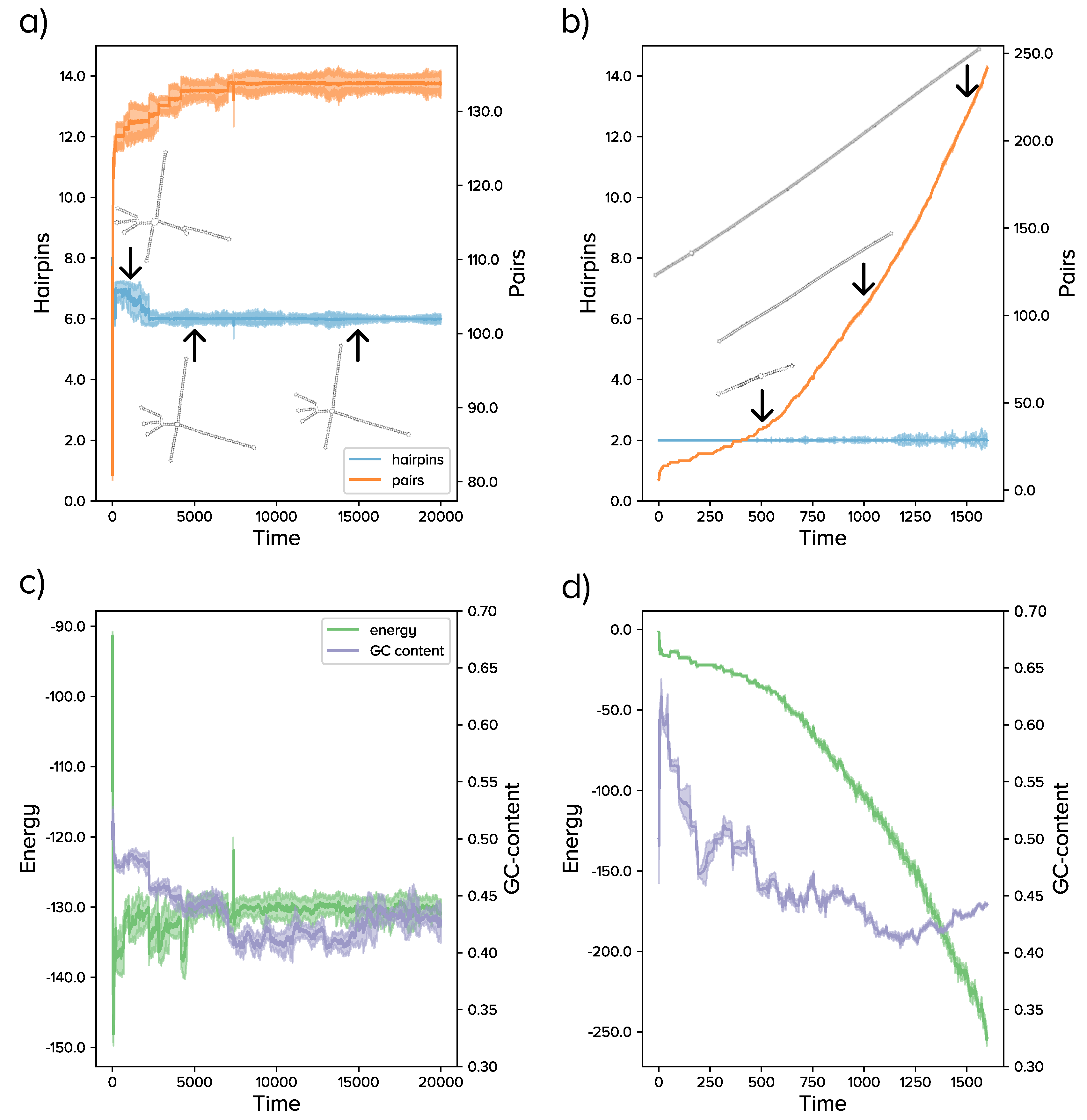
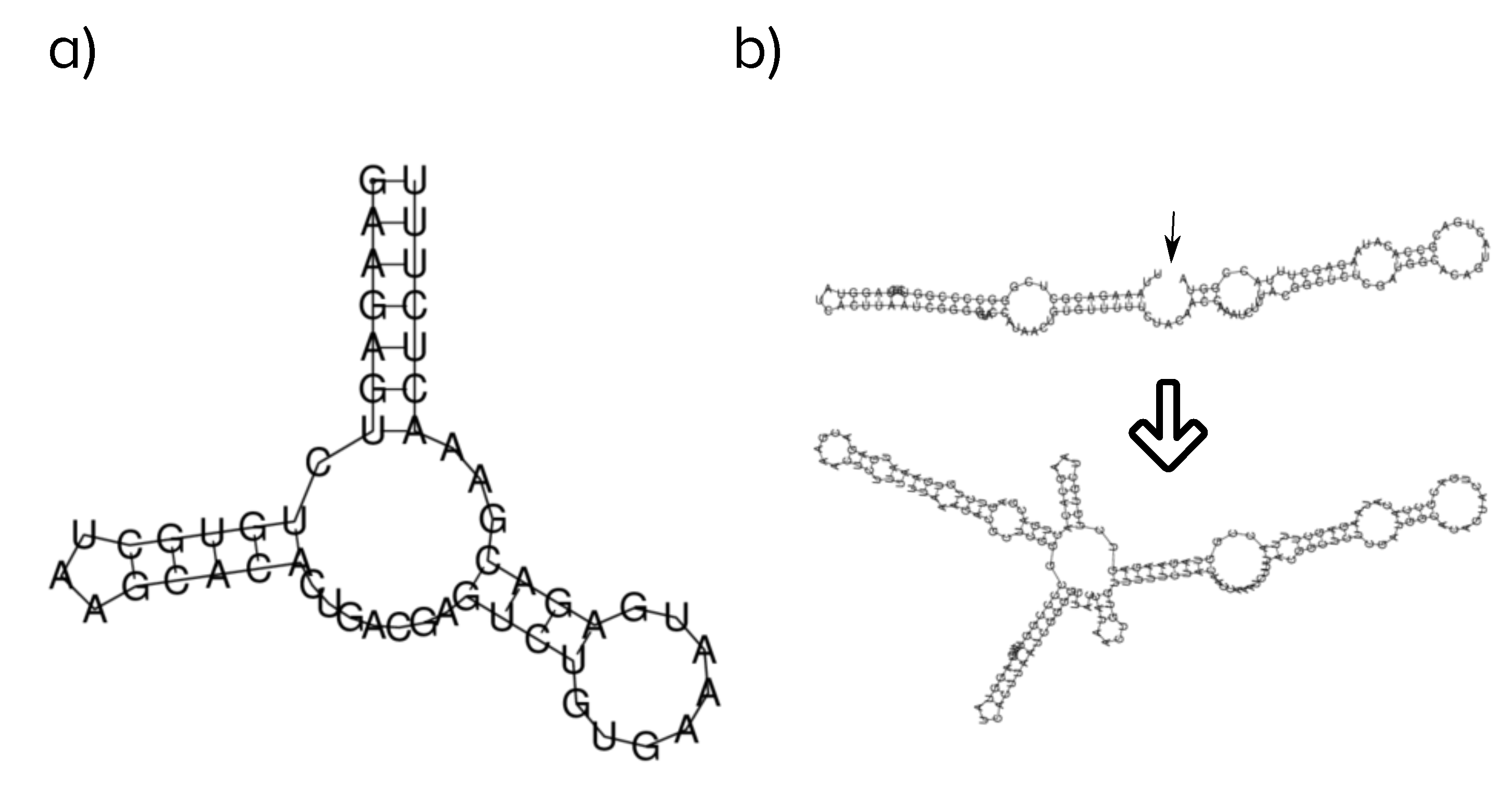
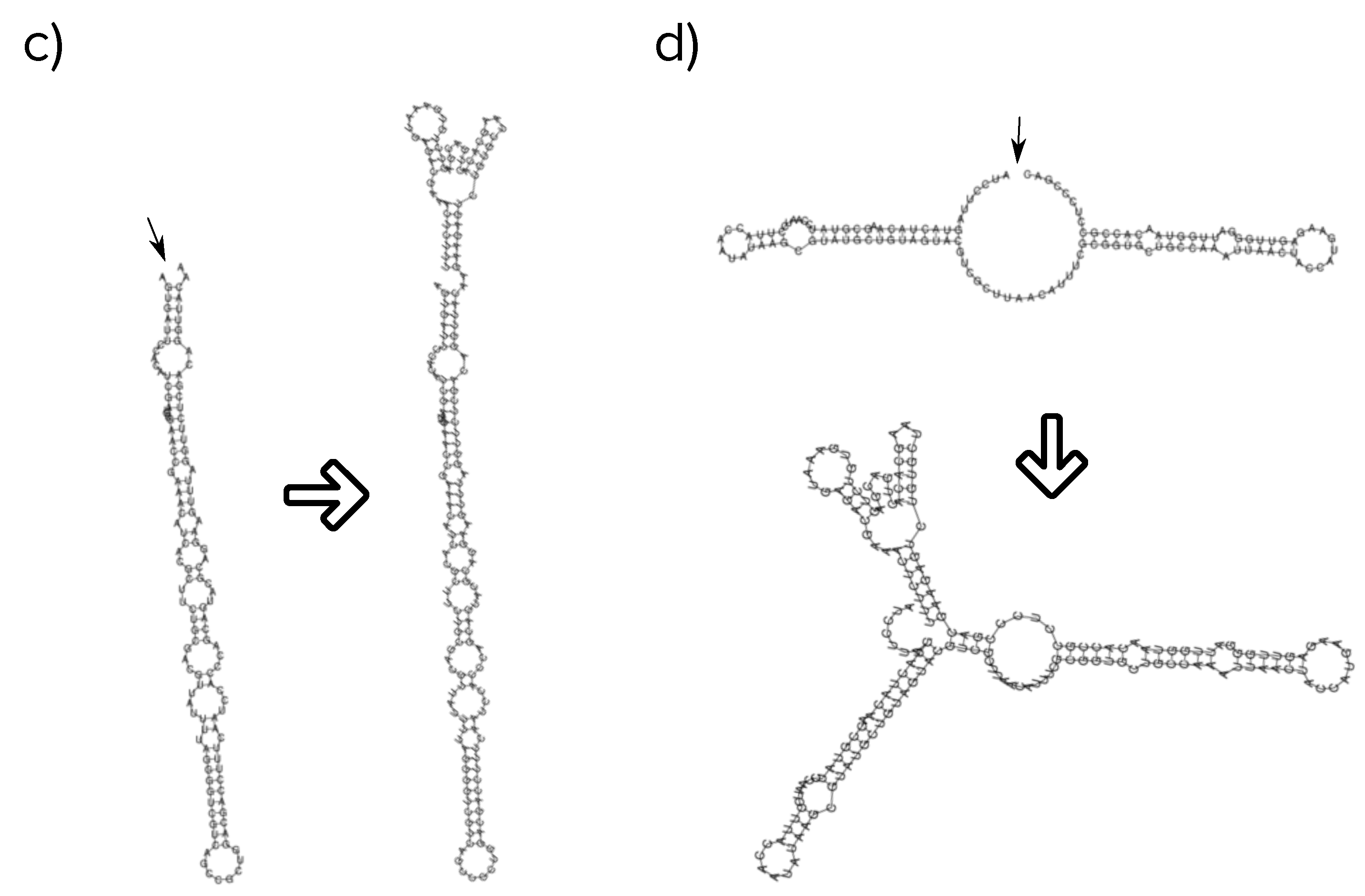
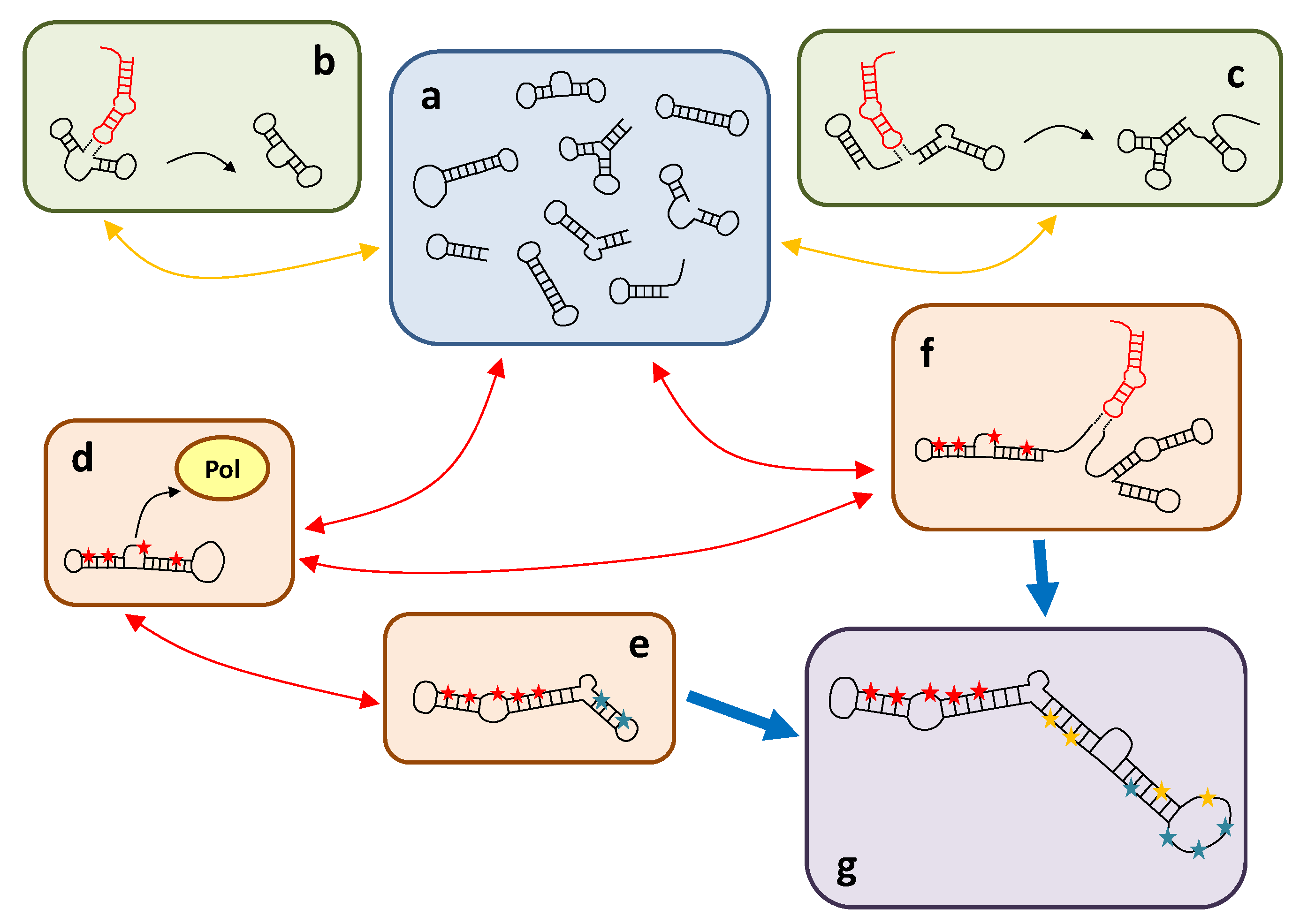
| Family | Genus | Species | ℓ | G + C % | h | p | |||
|---|---|---|---|---|---|---|---|---|---|
| Avsunviroidae | Avsunviroid | ASBVd | 247 | 38.1 | 3 | 10.0 | 84 | 71.5 | |
| Elaviroid | ELVd | 335 | 54.0 | 5 | 13.4 | 118 | 96.7 | ||
| Pelamoviroid | CChMVd | 399 | 55.4 | 12 | 15.8 | 140 | 115.1 | ||
| PLMVd | 337 | 52.5 | 8 | 13.4 | 121 | 97.3 | |||
| Pospiviroidae | Apscaviroid | ADFVd | 306 | 58.5 | 2 | 12.3 | 111 | 88.4 | |
| ASSVd | 329 | 60.5 | 2 | 13.1 | 110 | 95.0 | |||
| AGVd | 369 | 58.0 | 2 | 14.7 | 135 | 106.5 | |||
| CBLVd | 318 | 59.4 | 2 | 12.7 | 106 | 91.9 | |||
| CDVd | 294 | 54.4 | 2 | 11.8 | 101 | 85.0 | |||
| CVd-V | 294 | 60.2 | 2 | 11.8 | 102 | 85.0 | |||
| CVd-VI | 330 | 60.0 | 3 | 13.2 | 109 | 95.3 | |||
| GYSVd | 367 | 61.0 | 2 | 14.6 | 132 | 105.9 | |||
| GYSVd-1 | 363 | 60.0 | 7 | 14.4 | 133 | 104.8 | |||
| GYSVd-2 | 361 | 59.6 | 7 | 14.4 | 132 | 104.2 | |||
| PBCVd | 315 | 60.6 | 5 | 12.6 | 109 | 91.0 | |||
| PVd-2 | 358 | 59.8 | 6 | 14.2 | 128 | 103.3 | |||
| Cocadviroid | CBCVd | 284 | 55.6 | 2 | 11.4 | 102 | 82.1 | ||
| CCCVd | 246 | 59.3 | 2 | 10.0 | 84 | 71.2 | |||
| CTiVd | 254 | 60.2 | 2 | 10.3 | 81 | 73.5 | |||
| HLVd | 256 | 57.0 | 2 | 10.4 | 85 | 74.1 | |||
| Coleviroid | CBVd | 295 | 52.9 | 2 | 11.9 | 107 | 85.3 | ||
| CBVd-1 | 248 | 55.2 | 2 | 10.1 | 90 | 71.8 | |||
| CBVd-2 | 301 | 60.1 | 4 | 12.1 | 114 | 87.0 | |||
| CBVd-3 | 361 | 55.7 | 2 | 14.4 | 134 | 104.2 | |||
| Hostuviroid | DLVd | 342 | 58.8 | 2 | 13.6 | 120 | 98.7 | ||
| HSVd | 297 | 56.2 | 2 | 11.9 | 101 | 85.9 | |||
| Pospiviroid | CSVd | 354 | 52.8 | 2 | 14.1 | 125 | 102.2 | ||
| CEVd | 371 | 60.4 | 2 | 14.7 | 135 | 107.1 | |||
| CLVd | 370 | 58.1 | 2 | 14.7 | 128 | 106.8 | |||
| IrVd | 370 | 61.6 | 2 | 14.7 | 131 | 106.8 | |||
| MPVd | 360 | 58.9 | 2 | 14.3 | 126 | 103.9 | |||
| PCFVd | 348 | 59.2 | 2 | 13.9 | 125 | 100.5 | |||
| PSTVd | 359 | 58.2 | 2 | 14.3 | 129 | 103.6 | |||
| TASVd | 360 | 55.6 | 2 | 14.3 | 133 | 103.9 | |||
| TCDVd | 360 | 56.7 | 2 | 14.3 | 127 | 103.9 | |||
| TPMVd | 360 | 57.5 | 2 | 14.3 | 123 | 103.9 | |||
| Unclassified | AFCVd | 372 | 56.7 | 2 | 14.8 | 132 | 107.3 | ||
| CVd-VII | 368 | 52.2 | 3 | 14.6 | 128 | 106.2 | |||
| GLVd | 328 | 58.2 | 4 | 13.1 | 109 | 94.7 | |||
| PVd | 396 | 57.8 | 5 | 15.7 | 143 | 114.2 | |||
| RVd-I | 361 | 58.4 | 2 | 14.4 | 126 | 104.2 |
| ℓ | 3 | 4 | 5 | 6 | 7 | 8 | 9 | 10 | 11 | ||
|---|---|---|---|---|---|---|---|---|---|---|---|
| 10 | 2 | 1 | |||||||||
| 11 | 2 | 1 | |||||||||
| 12 | 2 | 2 | 1 | ||||||||
| 13 | 2 | 2 | 1 | ||||||||
| 14 | 2 | 3 | 2 | 1 | |||||||
| 15 | 2 | 3 | 2 | 2 | |||||||
| 16 | 2 | 4 | 3 | 6 | 1 | ||||||
| 17 | 2 | 4 | 3 | 10 | 3 | ||||||
| 18 | 2 | 5 | 4 | 19 | 9 | 1 | |||||
| 19 | 2 | 5 | 4 | 28 | 18 | 4 | |||||
| 20 | 2 | 6 | 5 | 44 | 33 | 16 | 1 | ||||
| 21 | 2 | 6 | 5 | 60 | 53 | 36 | 5 | ||||
| 3 | 1 | ||||||||||
| 22 | 2 | 7 | 6 | 85 | 81 | 82 | 23 | 1 | |||
| 3 | 2 | ||||||||||
| 23 | 2 | 7 | 6 | 110 | 116 | 151 | 64 | 6 | |||
| 3 | 7 | 1 | |||||||||
| 24 | 2 | 8 | 7 | 146 | 161 | 276 | 157 | 34 | 1 | ||
| 3 | 20 | 6 | |||||||||
| 25 | 2 | 8 | 7 | 182 | 215 | 452 | 322 | 106 | 7 | ||
| 3 | 42 | 21 | 2 | ||||||||
| 26 | 2 | 9 | 8 | 231 | 281 | 731 | 614 | 294 | 45 | 1 | |
| 3 | 84 | 56 | 14 | ||||||||
| 27 | 2 | 9 | 8 | 280 | 358 | 1106 | 1068 | 665 | 166 | 8 | |
| 3 | 156 | 126 | 57 | 4 | |||||||
| 28 | 2 | 10 | 9 | 344 | 449 | 1652 | 1773 | 1401 | 507 | 60 | 1 |
| 3 | 264 | 252 | 176 | 28 | |||||||
| 4 | 1 | ||||||||||
| 29 | 2 | 10 | 9 | 408 | 553 | 2360 | 2783 | 2668 | 1279 | 248 | 9 |
| 3 | 429 | 462 | 456 | 130 | 5 | ||||||
| 4 | 2 |
© 2019 by the authors. Licensee MDPI, Basel, Switzerland. This article is an open access article distributed under the terms and conditions of the Creative Commons Attribution (CC BY) license (http://creativecommons.org/licenses/by/4.0/).
Share and Cite
Catalán, P.; Elena, S.F.; Cuesta, J.A.; Manrubia, S. Parsimonious Scenario for the Emergence of Viroid-Like Replicons De Novo. Viruses 2019, 11, 425. https://doi.org/10.3390/v11050425
Catalán P, Elena SF, Cuesta JA, Manrubia S. Parsimonious Scenario for the Emergence of Viroid-Like Replicons De Novo. Viruses. 2019; 11(5):425. https://doi.org/10.3390/v11050425
Chicago/Turabian StyleCatalán, Pablo, Santiago F. Elena, José A. Cuesta, and Susanna Manrubia. 2019. "Parsimonious Scenario for the Emergence of Viroid-Like Replicons De Novo" Viruses 11, no. 5: 425. https://doi.org/10.3390/v11050425
APA StyleCatalán, P., Elena, S. F., Cuesta, J. A., & Manrubia, S. (2019). Parsimonious Scenario for the Emergence of Viroid-Like Replicons De Novo. Viruses, 11(5), 425. https://doi.org/10.3390/v11050425






